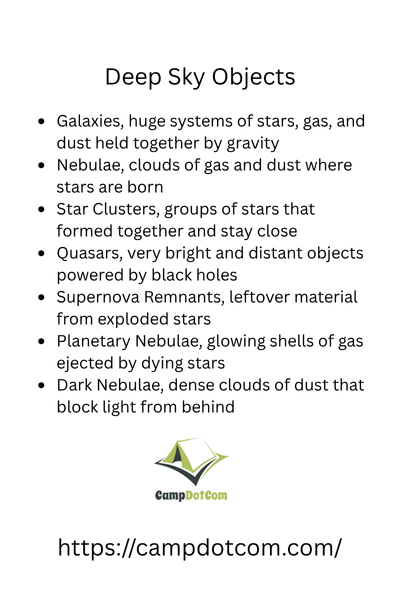If you have ever looked up at a clear night sky and felt that spark of wonder, you have probably already admired deep sky objects without even knowing their names. These fascinating sights include galaxies, star clusters, and nebulae. They are celestial wonders that exist far beyond our solar system. This article will explore what deep sky objects are, why they capture the imagination of sky watchers, and how you can observe them for yourself.
Read More About Deep Sky Objects

The First Time I Saw One
Let me tell you a little story. The first time I pointed my telescope beyond the moon and planets, I was not expecting much. Maybe a blurry patch or two. But I remember gasping out loud. Yes, literally gasping. When I found the Andromeda Galaxy, it was faint, sure, but there it was. Another freaking galaxy, two point five million light years away, just hanging out in the sky. And that was when I was officially hooked on deep sky objects.
So, What Are Deep Sky Objects Anyway?
Deep sky objects or DSOs for short are the cool kids of the cosmos. They include everything beyond our solar system such as galaxies, nebulae, star clusters, and more. Basically, when you are done checking out Jupiter’s moons, these are your next big adventure.
As an Amazon Associate, I earn from qualifying purchases. Some of the links in this article are affiliate links. This means that, at zero cost to you, I will earn an affiliate commission if you click through the link and finalize a purchase.
More Things to Know About Deep Sky Objects

There is something deeply satisfying about hunting down a fuzzy blob in the dark, knowing it is a cloud of gas where stars are being born or a collection of a hundred billion suns. It makes you feel small and huge at the same time, does it not?
You Don’t Need Fancy Gear
Here’s a fun twist: you don’t need a space-grade telescope to see deep sky objects. A simple pair of binoculars will get you started. I’ve spotted the Orion Nebula, the Pleiades cluster, and even the Hercules Globular Cluster with a beat-up pair I bought at a garage sale. Don’t let gear snobs scare you off—you can do a ton with what you’ve already got.
That said, if you’ve got a telescope, you’re golden. Just don’t forget a good star chart or an app to help you find your way. The sky’s a big place, and trust me, it’s easy to get lost. (Been there. More than once.)
Favorite Deep Sky Objects to Spot
Okay, this is where things get fun. Here are some of my all-time favorites, especially for beginners:
- Orion Nebula (M42): Super bright, super rewarding. You can’t miss it—it’s the fuzzy patch in Orion’s sword.
- The Pleiades (M45): Also known as the Seven Sisters. It looks like a tiny dipper made of blue diamonds.
- Andromeda Galaxy (M31): The closest spiral galaxy to ours. Seeing it is like peeking into another universe.
- The Ring Nebula (M57): This one looks like a ghostly donut in Lyra. Yes, a space donut.
- The Dumbbell Nebula (M27): I have no idea why it’s named after gym equipment, but it’s a stunner in a medium scope.
Tips for Better Viewing
You will want dark skies, really dark. City lights wash out all but the brightest deep sky objects, so head out to the countryside if you can. And give your eyes time to adjust to the dark. It can take twenty to thirty minutes, but you will see much more detail once your night vision is fully working.
Also, do not rush. Some of these objects are subtle. Let your eyes linger. Breathe. Enjoy the stillness.
And hey, if your neighbors think you are strange for standing in the backyard at midnight staring into a tube, congratulations. You are doing it correctly.
Why Deep Sky Objects Are Worth Your Time
There’s something magical about connecting with the universe like this. These aren’t just pretty sights—they’re windows into cosmic history. That light you’re seeing? It left the object long before you were born. In some cases, before humans even existed. That’s wild, right?
Every time I track down one of these deep sky objects, I feel like I’m tuning into the universe’s greatest hits album. It’s awe-inspiring, a little humbling, and just plain cool.
Plus, it’s a great excuse to stay up late, drink coffee under the stars, and lose yourself in a sky that has no edges.
Embracing the Wonder of Deep Sky Objects in Our Night Skies
Look, I know there are many hobbies out there. But few offer the kind of quiet thrill that deep sky objects provide. You are not just looking, you are exploring. You are chasing ancient light across the sky. And you are part of a long tradition of curious sky watchers, from ancient stargazers to modern astrophotographers.
So the next time you find yourself under a clear night sky, take a moment. Look up. Grab those binoculars or dust off that telescope. The universe is waiting, and those deep sky objects are not going to discover themselves.
Have you spotted any deep sky objects lately? Do you have a favorite? I would love to hear what you have seen out there in the vast dark. Leave a comment and let us talk stars.
